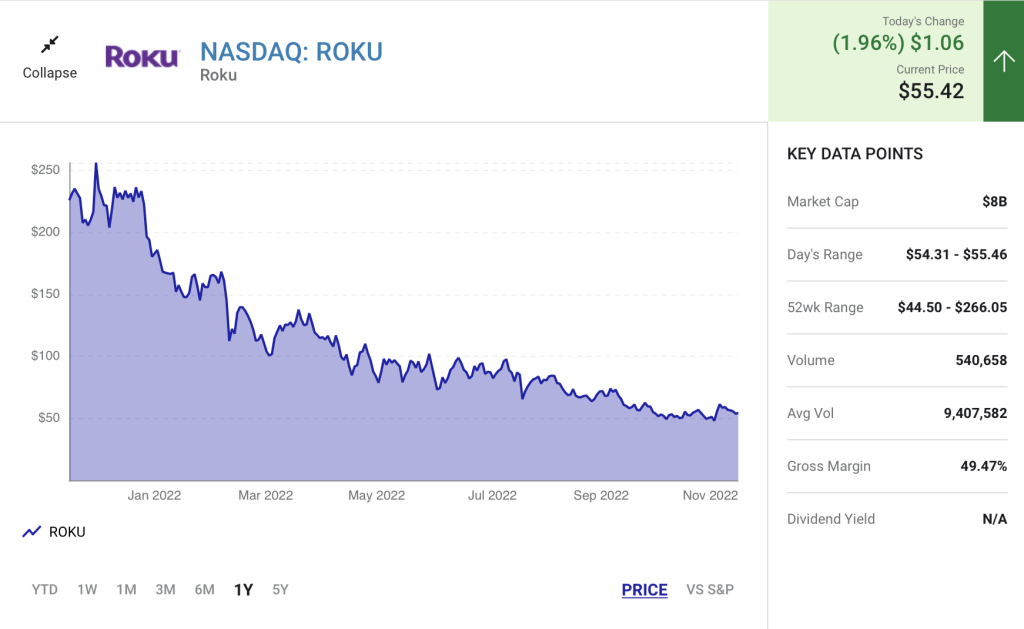Roku has been mauled by the bear market, but this too will pass.
The bear market has ravaged technology stocks over the past year, as investors have flown to safety to ride out the economic storm. This has been further exacerbated by 40-year-high inflation, rising interest rates, and questions about how long the downturn will persist. As a result, the Nasdaq Composite has taken it on the chin, crumbling 30% over the past year.
As painful as this period is, this dark cloud has a silver lining: Even as paper losses mount, the ongoing sell-off has resulted in some remarkable opportunities for investors. Perhaps one of the best examples of this is Roku(ROKU 1.96%). The company, which boasts the world’s most widely used streaming platform, has seen its stock price decline 77%, despite a strong history of growth and an industry-leading position.
Can Roku overcome the gale-force economic headwinds that have buffeted its stock in 2022? Let’s take a step back and look at the big picture.
Where will the audience come from?
The ongoing narrative lately has been that streaming video’s best growth is over. Streaming is falling out of favor, as the current economic conditions have stripped Roku of its growth opportunity — but let’s review the evidence.
The secular decline of cable TV continues, as cord-cutting continues to accelerate. The major pay-TV services have shed roughly 4.6 million subscribers through the first nine months of 2022, and are on pace to exceed their record losses suffered in 2020, according to data provided by Leichtman Research Group. Logic suggests that all these former cable subscribers are turning to streaming video for their in-home entertainment needs.
What streaming fatigue?
The naysayers suggest that viewers have begun to tire of streaming video and paid services — a phenomenon described as “streaming fatigue.” The story further goes that viewers had their fill of streaming video at the height of the pandemic, and growth for the sector is over — but the data suggests otherwise.
Streaming video consumption grew 35.1% year over year in October and now accounts for 37.3% of TV viewing, according to data compiled by Nielsen. Broadcast television slumped 6.2% year over year, while cable TV audiences declined 8.6%. Furthermore, all of the major streaming services have continued to grow market share — albeit at a slower pace.
The numbers don’t lie
Not many companies can say they’ve gone up against Amazon and won, but Roku counts itself among that select few. Roku is the most popular streaming device in the world, with a 23% share of all devices globally, according to Conviva. For context, Amazon’s Fire TV came in a distant second with just 12%.
Roku also has twice as many streaming apps/channels available on its platform as Amazon, with more than 33,000 apps on its app store, according to mobile and connected TV app intelligence company 42matters. Compare that to fewer than 17,000 for Fire TV, and the advantage is clear.

Roku’s secret weapon
Roku has a secret weapon that helped it become the worldwide audience leader. Roku developed its operating system (OS) from the ground up and licensed it to connected TV manufacturers that aren’t looking to reinvent the wheel. That gives Roku a captive audience of viewers looking to access streaming services via its platform. Roku is the No. 1 smart TV OS in the U.S., No. 2 in Mexico, and is gaining meaningful share in a number of other countries around the world.
It’s worth noting that supply chain issues have persisted, particularly for smart TVs and streaming devices imported from China. As a result, Roku’s account growth has slowed, but is expected to ramp back up once these backlogs have cleared.
Short-term headwinds, long-term opportunity
In times of economic upheaval, companies frequently scale back on marketing spending. Roku gets a 30% cut of all the advertising on its platform, so the segment has taken a hit. This was evident in the company’s third-quarter financial report, as revenue grew just 12% year over year, weighed down by slower ad growth and lower margins on its devices.
Its service-agnostic platform, which profits from paid subscription and ad-supported channels alike, is set to get a boost from a number of new ad-supported channels, including those from Netflix and Disney+ — two of the world’s most popular streaming services.
The time is now
Taken in total, the evidence shows that Roku is a company well-positioned to capitalize on the secular trend away from broadcast and cable TV and toward streaming. This means that once the bear market goes back into hibernation, Roku stock should come roaring back.
Over the past year, the stock has been absolutely punished, down 77%. That puts Roku squarely in bargain-basement territory, selling for just 2 times next year’s sales — its lowest valuation ever.
That’s not to say that the stock couldn’t fall further — history shows that it certainly could. However, given the company’s history of growth and innovation and its industry-leading position, investors would do well to invest now, before Roku stock starts to soar.
Read Next – Bloomberg: This tiny company’s tech could “solve the energy crisis.”
It’s time for you to take part in the greatest energy revolution of our lifetime.
It’s projected to be 10X bigger than the electric vehicle revolution…
Which turned an early $500 investment in Tesla into $207,000.
And it will be bigger than the solar power revolution…
Which would have turned a $2,500 investment in Enphase Energy into over $1 million.
This is the gretaest energy investing opportunity of our lifetimes.
And the best part is…
According to Bloomberg, President Biden has “almost guaranteed” that investors will have a shot at making a fortune from this brand new type of energy.
Because it holds the key to “solving the energy crisis” in America.
And Biden has authorized $80 billion be spent immediately to bring this new type of energy to market ASAP.
And for the small company at the center of this energy revolution, their share price is about to go through the roof.
A small $500 stake could potentially turn into $234,000.
Those billions of federal funding are set to be dispensed every minute…
And when that happens, this stock is expected to rocket to the moon.
So, you need to see the details about this opportunity right now.



